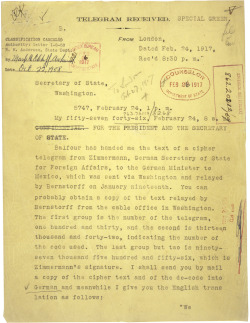By Michael Hogan
The Zimmermann telegram and the Mexican temptation
Most students of U.S.-Mexico relations know that Mexico lost two-fifths of its territory as a result of the Mexican-American War of 1846-48 and the ensuing Treaty of Guadalupe Hidalgo. However, few are aware that 69 years later, a powerful European nation offered to intercede and unite its prodigious military forces with those of Mexico and recover the lost territories of Arizona, Texas, and New Mexico. It would have been the most powerful military alliance in the history of the Americas.

The year was 1917. U.S. ground and air forces, under Gen. John “Black Jack” Pershing, was coming to the end of their fruitless search for Pancho Villa, who had conducted his own invasion of U.S. territory, leaving a swath of bodies behind in Columbus, New Mexico. Germany was engaged in a major war with England and was destroying allied shipping to European ports with its deadly submarines. Germany had been careful up to this point to avoid sinking American ships headed for England because it did not want to provoke the United States into entering the war. However, more bellicose counsel prevailed and, in early 1917, the decision to begin unrestricted warfare in the Atlantic was made.
Knowing that the United States would react and begin war preparations, German leaders conceived of a plan to stall them. They would invite Mexico, which was neutral at the time, to join the Central Powers (Germany, Austria-Hungary, Bulgaria, and the Ottoman Empire). In exchange, Germany would ally itself with Mexico and help her seize the territories of Texas, Arizona, and New Mexico. While it may seem far-fetched from our historical vantage point, it was a plausible scenario at the time. Unrestricted submarine warfare would cut off armaments and supplies to both England and France, forcing them to the bargaining table to discuss peace. The Germans and their allies would thus be free to assist Mexico as it moved north to recover its lost territories in the southwest United States.

But there was a fly in the ointment. A member of the British secret service uncovered the telegram sent by German Foreign Secretary Arthur Zimmermann to his counterpart in Mexico City, outlining the proposal. Not only the British but now the Americans knew about the German offer. Still, the parties were on tenterhooks because Mexico was engaged in a bloody civil war, known as the Mexican Revolution, and the outcome of that conflict was not fully decided. President Venustiano Carranza was no friend of the United States and resented the long history of incursions by Americans in the 20th century, from an invasion of Veracruz in 1914, to the latest, in 1916, by Gen. Pershing. However, with the fighting ongoing, his position was far from secure.

Woodrow Wilson, for his part, was no fool. Unwilling to risk having an enemy at his back, his ambassador approached Carranza and entered formal discussions. The United States then proceeded to withdraw Pershing’s army from Mexico, where it had been chasing Villa, freeing them to be sent as an expeditionary force to Europe to aid the Allies. The United States also offered de jure recognition of Carranza’s regime as the legitimate inheritor of the revolution, thus ensuring their neutrality during the remainder of World War I.

It was a win-win for all sides. The United States now had a secure southern border and a guaranteed supply of oil. Following the U.S. lead, nations throughout the world recognized the Carranza government, thus solidifying the new regime and making it eligible for loans and other assistance to aid in its recovery from seven years of warfare. France and England would be helped enormously by the United States, which would send armed forces and additional munitions and supplies to Europe, thus ensuring an Allied victory.
A victory for all sides? What about Germany? Carranza was a hard bargainer. He insisted that his country’s neutrality protected German diplomats and businesses, which continued to thrive during the war and for the following two decades. Germans today remember Mexico fondly for its help during that difficult period. It was not until May 1942 when Mexico finally broke relations and joined the Allies against a far more dangerous regime.
Source: warhistoryonline.com, northamericanproject.com





